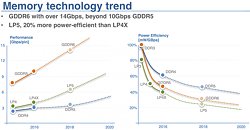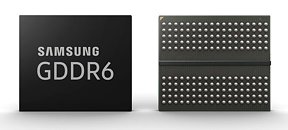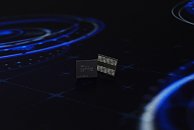Raevenlord
News Editor
- Joined
- Aug 12, 2016
- Messages
- 3,755 (1.15/day)
- Location
- Portugal
| System Name | The Ryzening |
|---|---|
| Processor | AMD Ryzen 9 5900X |
| Motherboard | MSI X570 MAG TOMAHAWK |
| Cooling | Lian Li Galahad 360mm AIO |
| Memory | 32 GB G.Skill Trident Z F4-3733 (4x 8 GB) |
| Video Card(s) | Gigabyte RTX 3070 Ti |
| Storage | Boot: Transcend MTE220S 2TB, Kintson A2000 1TB, Seagate Firewolf Pro 14 TB |
| Display(s) | Acer Nitro VG270UP (1440p 144 Hz IPS) |
| Case | Lian Li O11DX Dynamic White |
| Audio Device(s) | iFi Audio Zen DAC |
| Power Supply | Seasonic Focus+ 750 W |
| Mouse | Cooler Master Masterkeys Lite L |
| Keyboard | Cooler Master Masterkeys Lite L |
| Software | Windows 10 x64 |
This news may really not come as such; it's more of a statement in logical, albeit unconfirmed facts rather than something unexpected. AMD is working (naturally) on a GDDR6 memory controller, which it's looking to leverage in its next generations of graphics cards. This is an expected move: AMD is expected to continue using more exotic HBM memory implementations on its top tier products, but that leaves a lot of GPU space in their product stack that needs to be fed by high-speed memory solutions. With GDDR6 nearing widespread production and availability, it's only natural that AMD is looking to upgrade its controllers for the less expensive, easier to implement memory solution on its future products.
The confirmation is still worth mention, though, as it comes straight from a principal engineer on AMD's technical team, Daehyun Jun. A Linked In entry (since removed) stated that he was/is working on a DRAM controller for GDDR6 memory since September 2016. GDDR6 memory brings advantages of higher operating frequencies and lower power consumption against GDDR5 memory, and should deliver higher potential top frequencies than GDDR5X, which is already employed in top tier NVIDIA cards. GDDR6, when released, will start by delivering today's GDDR5X top speeds of roughly 14 Gbps, with a current maximum of 16 Gbps being achievable on the technology. This means more bandwidth (up-to double over current 8 Gbps GDDR5) and higher clock frequency memory. GDDR6 will be rated at 1.35 v, the same as GDDR5X.




SK Hynix, Samsung, and Micron have all announced their GDDR6 processes, so availability should be enough to fill NVIDIA's lineup, and AMD's budget and mainstream graphics cards, should the company choose to do so. Simpler packaging and PCB integration should also help in not lowering yields from usage of more complex memory subsystems.
View at TechPowerUp Main Site
The confirmation is still worth mention, though, as it comes straight from a principal engineer on AMD's technical team, Daehyun Jun. A Linked In entry (since removed) stated that he was/is working on a DRAM controller for GDDR6 memory since September 2016. GDDR6 memory brings advantages of higher operating frequencies and lower power consumption against GDDR5 memory, and should deliver higher potential top frequencies than GDDR5X, which is already employed in top tier NVIDIA cards. GDDR6, when released, will start by delivering today's GDDR5X top speeds of roughly 14 Gbps, with a current maximum of 16 Gbps being achievable on the technology. This means more bandwidth (up-to double over current 8 Gbps GDDR5) and higher clock frequency memory. GDDR6 will be rated at 1.35 v, the same as GDDR5X.




SK Hynix, Samsung, and Micron have all announced their GDDR6 processes, so availability should be enough to fill NVIDIA's lineup, and AMD's budget and mainstream graphics cards, should the company choose to do so. Simpler packaging and PCB integration should also help in not lowering yields from usage of more complex memory subsystems.
View at TechPowerUp Main Site





